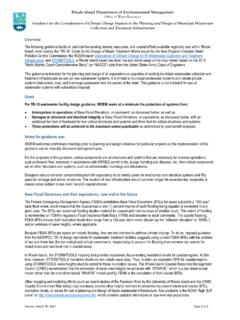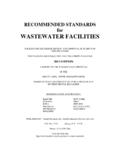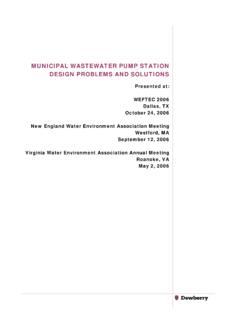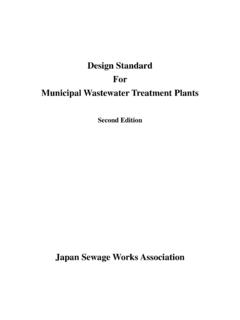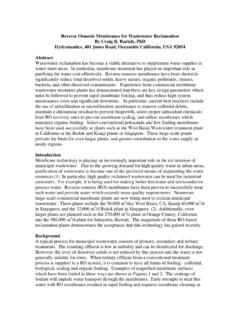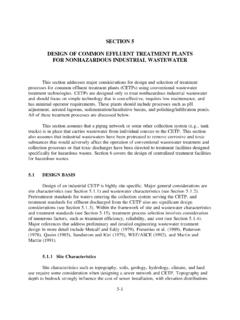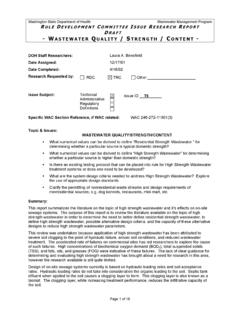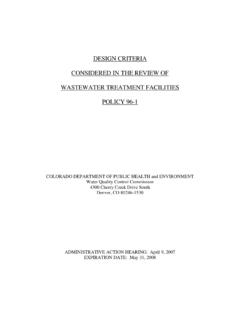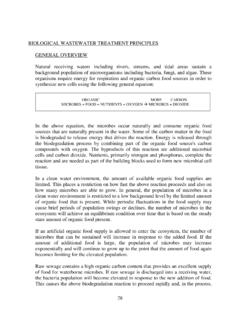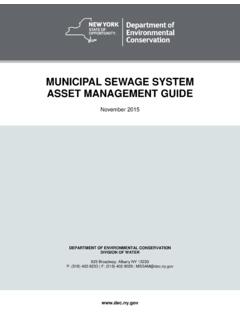Transcription of Land Treatment of Municipal Wastewater Effluents
1 Process design ManualLand Treatment of MunicipalWastewater EffluentsEPA/625/R-06/016 September 2006 Process design Manual land Treatment of Municipal Wastewater Effluents land Remediation and Pollution Control Division National Risk Management Research Laboratory Office of Research and Development Environmental Protection Agency Cincinnati, Ohio Notice This document has been reviewed in accordance with Environmental Protection Agency policy and approved for publication. Mention of trade names or commercial products does not constitute endorsement or recommendation for use. ii Foreword The Environmental Protection Agency (EPA) is charged by Congress with protecting the Nation s land , air, and water resources. Under a mandate of national environmental laws, the Agency strives to formulate and implement actions leading to a compatible balance between human activities and the ability of natural systems to support and nurture life.
2 To meet this mandate, EPA s research program is providing data and technical support for solving environmental problems today and building a science knowledge base necessary to manage our ecological resources wisely, understand how pollutants affect our health, and prevent or reduce environmental risks in the future. The National Risk Management Research Laboratory (NRMRL) is the Agency s center for investigation of technological and management approaches for preventing and reducing risks from pollution that threaten human health and the environment. The focus of the Laboratory s research program is on methods and their cost-effectiveness for prevention and control of pollution to air, land , water, and subsurface resources; protection of water quality in public water systems; remediation of contaminated sites, sediments and ground water; prevention and control of indoor air pollution; and restoration of ecosystems.
3 NRMRL collaborates with both public and private sector partners to foster technologies that reduce the cost of compliance and to anticipate emerging problems. NRMRL s research provides solutions to environmental problems by: developing and promoting technologies that protect and improve the environment; advancing scientific and engineering information to support regulatory and policy decisions; and providing the technical support and information transfer to ensure implementation of environmental regulations and strategies at the national, state, and community levels. This publication has been produced as part of the Laboratory s strategic long-term research plan. It is published and made available by EPA s Office of Research and Development to assist the user community and to link researchers with their clients. Sally Gutierrez, Director National Risk Management Research Laboratory iii Abstract The Environmental Protection Agency guidance on land Treatment of Municipal and industrial Wastewater was updated for the first time since 1984.
4 Significant new technological changes include phytoremediation, vadose zone monitoring, new design approaches to surface irrigation, center-pivot irrigation, drip and micro-sprinkler irrigation, and capital and operating costs. Also included in the new manual are new performance data on soil-aquifer Treatment , a rational model for balancing oxygen uptake with BOD loadings, and industrial Wastewater land application guidance, emphasizing Treatment of food processing Wastewater . Costs and energy use of land Treatment technologies are updated. Slow-rate land Treatment remains the most popular type of land Treatment system. Many slow-rate systems are now designed as water reuse systems. Trends in distribution have been toward sprinkler and drip irrigation systems. A CD which accompanies the document contains copies of earlier editions of the land Treatment manual and the latest manual for water reuse.
5 KEYWORDS: land Treatment , soil aquifer Treatment , spray irrigation, groundwater monitoring, vadose zone sampling, costs iv Contents Notice .. ii Foreword .. iii Abstract .. iv Contents .. v Figures .. viii x Acknowledgments .. xiii Chapter 1 Introduction and Process 1-1 Purpose .. 1-1 Scope .. 1-1 Treatment Processes .. 1-1 Slow Rate land Treatment .. 1-2 Overland Flow 1-4 Soil Aquifer Treatment .. 1-4 Limiting design Parameter Concept .. 1-7 Guide to Intended Use of Manual .. 1-7 References .. 1-7 Chapter 2 Wastewater Constituents and Removal Mechanisms .. 2-1 Biochemical Oxygen 2-1 Total Suspended Solids .. 2-2 Oil and Grease .. 2-2 2-3 Pathogenic 2-3 2-6 2-8 Phosphorus.
6 2-11 Potassium .. 2-14 Sodium .. 2-14 Macronutrients and 2-14 Trace 2-16 Phytoremediation .. 2-18 References .. 2-19 Chapter 3 Water Movement in Soil and Groundwater .. 3-1 Soil Properties .. 3-2 Water Movement through Soil .. 3-4 Saturated Hydraulic 3-7 Unsaturated Hydraulic 3-8 Percolation Capacity .. 3-8 Mounding of Groundwater .. 3-9 Drainage Requirements .. 3-11 Field Testing Procedures .. 3-12 References .. 3-18 v Chapter 4 Role of Plants in land 4-1 Vegetation in land 4-1 Evapotranspiration .. 4-1 Plant Selection .. 4-4 Crop Management, Water Quality, and Nutrient 4-14 References .. 4-16 Chapter 5 Site Planning and Selection .. 5-1 Preliminary land 5-1 Site 5-4 Site Selection.
7 5-8 Phase 2 Planning .. 5-8 Cost and Energy Considerations .. 5-17 References .. 5-23 Chapter 6 Preapplication Treatment and Storage .. 6-1 EPA 6-1 Types of Preapplication Treatment .. 6-2 design of Storage Ponds .. 6-7 Operation of Storage Ponds .. 6-12 References .. 6-12 Chapter 7 Distribution Systems .. 7-1 Types of Distribution Systems .. 7-1 General design Considerations for All Types of Distribution Systems .. 7-3 Surface 7-4 Sprinkler Distribution .. 7-11 Micro Irrigation Distribution System Planning and 7-22 Pumping Stations and 7-26 Distribution Pumping .. 7-26 Tailwater Pumping .. 7-26 Mainlines .. 7-27 References .. 7-27 Chapter 8 Process design Slow Rate 8-1 System Types .. 8-1 land Area Determination.
8 8-1 Total Acidity 8-4 8-4 design Considerations .. 8-7 Crop, Soil, and Site Management Requirements .. 8-9 References .. 8-15 Chapter 9 Process design Overland Flow Systems .. 9-1 System 9-1 design 9-2 land Area Requirements .. 9-5 design Considerations .. 9-6 System Monitoring and Management .. 9-8 References .. 9-9 Chapter 10 Process design Soil Aquifer Treatment .. 10-1 Treatment Requirements .. 10-1 Aquifer Characteristics .. 10-4 Hydraulic Loading Rates .. 10-5 vi land Area Requirements .. 10-7 Hydraulic Loading Cycle .. 10-7 design Considerations .. 10-8 Cold Weather Operation .. 10-9 10-10 References .. 10-12 Chapter 11 Industrial Wastewater land Application .. 11-1 Types of Industrial Wastewaters 11-1 Water Quality and Pretreatment Requirements.
9 11-1 design Considerations .. 11-4 Slow-Rate land Treatment .. 11-6 Overland Flow 11-7 Soil Aquifer Treatment .. 11-8 References .. 11-9 vii Figures Number Page 1-1 Slow Rate Hydraulic Pathways .. 1-3 1-2 Overland 1-5 1-3 SAT Hydraulic Pathways .. 1-6 2-1 Nitrogen Cycle in 2-9 3-1 Natural Resources Conservation Service (NRCS) Soil Textural Classes .. 3-2 3-2 Porosity, Specific Yield, Specific Retention vs. Soil Grain Size for In situ Consolidated Soils, Coastal Basin, CA .. 3-6 3-3 Specific Yield vs. Hydraulic Conductivity .. 3-6 3-4 Soil Moisture Characteristics .. 3-6 3-5 Approximate Preliminary Percolation Rate vs. NRCS Soil Permeability for SR and SAT.
10 3-9 3-6 Schematic of Groundwater Mound .. 3-9 3-7 Mounding Curve for Center of a Square Recharge 3-10 3-8 Mounding Curve for Center of a Rectangular recharge Area, with Different Ratios of Length L to Width 3-10 3-9 Rise and Horizontal Spread of a Mound Below a Square Recharge Area ..3-11 3-10 Rise and Horizontal Spread of Mounds Below a Rectangular Recharge Area when L = 3-11 3-11 Parameters Used in Drain design .. 3-12 3-12 Small-scale Pilot Test Basin .. 3-13 3-13 Army Corps of Engineers (USACE) Basin Test ..3-13 3-14 Grove Preparation for USACE Test .. 3-14 3-15 Grove Preparation for USACE Test .. 3-14 3-16 Typical Test Results, USACE Infiltration 3-14 3-17 Test Installation for Cylinder Infiltrometer .. 3-15 3-18 Definition Sketch for Air Entry Permeameter .. 3-15 3-19 Air Entry Permeameter in Use .. 3-15 3-20 Definition Sketch for Auger Hole Technique.

